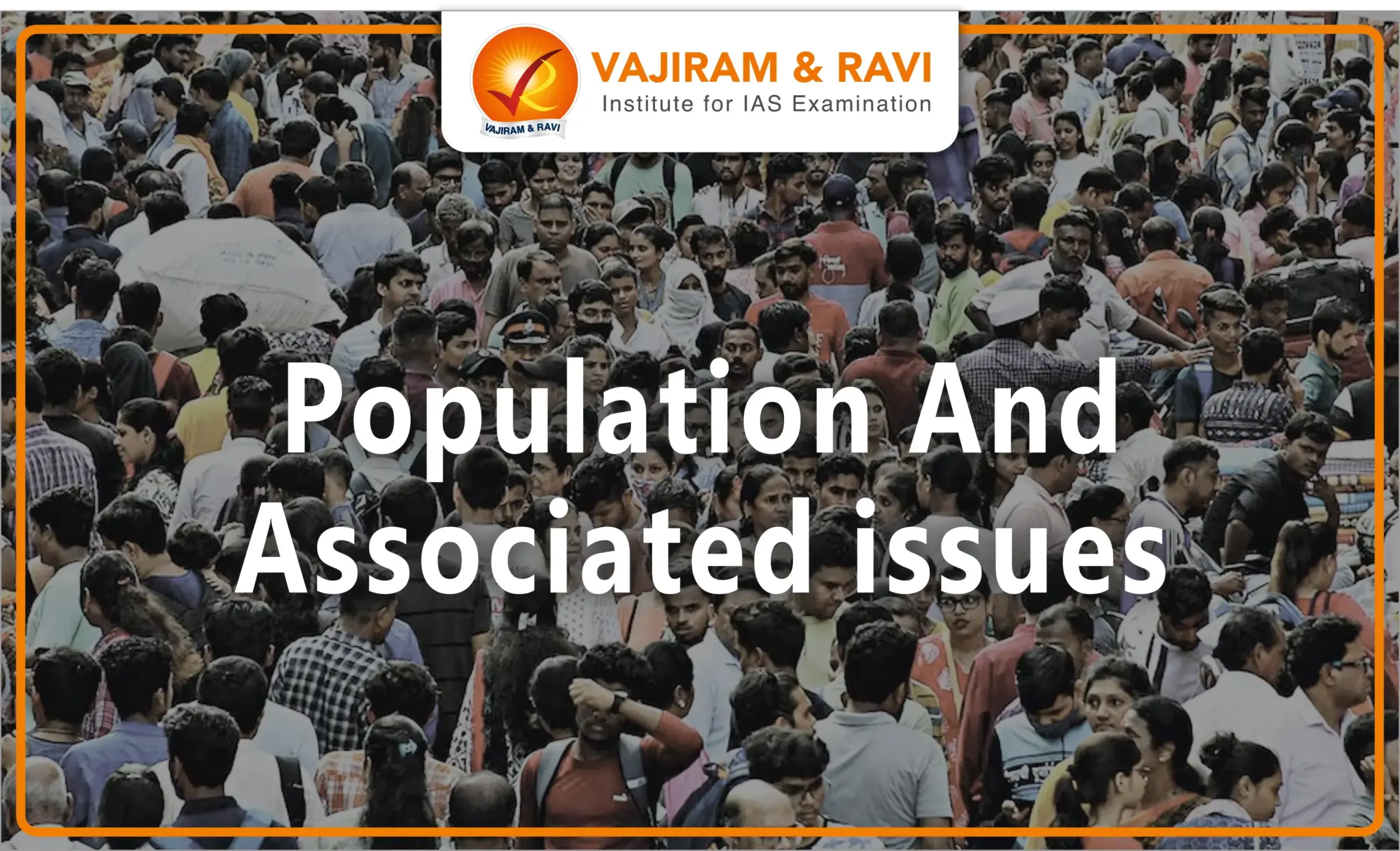India is the most populous country in the world with 1.44 billion people. Surpassing China recently. It will continue to rise until reaching 1.52 billion by 2036, according to India’s National Commission on Population. India has a huge advantage as well as challenges to tap the potential benefits of its large population with religious and ethnic diversities.
The Government of India has taken several steps to directly control the population growth. India was the first country to launch a national programme of family planning in 1952, that emphasised the necessity of reducing birth rates to stabilize the population.
Salient Features of India’s Population
With a population of over 1.42 billion, India is the most populous country in the world. Following are the key characteristics of the population of India.
- Stage of demographic transition: India is currently in the second stage, characterised by a high population growth rate due to the combination of high birth rates and declining death rates.
- High population density: India’s population density is high and rapidly rising, currently standing at around 464 people per square kilometre.
- Skewed Sex Ratio: India has a skewed sex ratio, with a preference for male children leading to a higher number of males than females. This has led to an unfavourable sex ratio at birth for children of 931 as per NFHS-5.
- Youngest Population: India has a relatively young population with 68% of India’s population being between 15-64 years old in 2022.
- Skewed Population across the states: India’s population is not evenly distributed across the country, with large variations among states.
- Some states, like Uttar Pradesh and Bihar, have a much higher population and density than others, like Mizoram and Arunachal Pradesh.
India’s Population
- United Nations (UN) World Population Prospects 2022:
- India is projected to overtake China as the world’s most populous country in 2023, “with prospects to reap the demographic dividend as the median age of an Indian this year was 28.7 years.
- India overtook China on 24 April 2023.
- India’s population stands at 1.412 billion in 2022 and is projected to have a population of 1.668 billion in 2050.
- 68% of India’s population is between 15-64 years old in 2022, while people aged 65 and above comprise % of the population.
- National Family Health Survey-5:
- The Total Fertility Rate (TFR), the average number of children per woman, has further declined to 2.0 reaching below the Replacement level fertility of 2.1.
- Overall Contraceptive Prevalence Rate (CPR) has increased substantially from 54% to 67% in the country.
Social Factors for the Population Growth of India
- High fertility: The accessibility of contraceptives is still relatively more difficult in remote rural and tribal areas.
- Low mortality: A decrease in the death rate as well as infant mortality rate due to improved healthcare facilities is one of the major causes of population growth.
- Early marriage of girls: According to NFHS-5, 23.3% of women surveyed got married before attaining the legal age of 18 years.
- Son preference: As per the Economic Survey 2018, India’s meta-preference for sons led to 21 million unwanted girls.
- The adverse sex ratio of females to males has led to 63 million ‘missing women’
- Poverty and educational backwardness: The families living in poverty are those having the most children because they are consistently trapped in poverty from generation to generation with little opportunity.
- Religious beliefs: Where some communities believe that children are gifts of god.
Benefits of India’s Large Population
India’s large population can bring several advantages. Some of them are described here.
- A large workforce: India’s large population means that it has a large and diverse workforce, which can be a significant advantage for the country’s economy.
- A large consumer market: India’s large population also means that it has a large consumer market and India’s economy is mainly driven by consumption.
- Demographic dividend: India’s large population of youth can bring a demographic dividend, which is when a relatively large proportion of working-age people in the population can support a relatively small proportion of older people.
- Export of Human Resources: India’s large population of young and skilled individuals can be an advantage for the export of human resources to ageing countries, such as the developed countries of Europe, North America and East Asia that have a shortage of skilled workers.
Issues Associated with the Overpopulation
The overpopulation has led to several issues in the country from social, political, economic and ecological perspectives. These issues are described below:
- Poverty: Population growth has led to increased competition for jobs and housing, which has contributed to poverty and income inequality.
- High population density often exacerbates income inequality as the number of job seekers exceeds available opportunities. This results in income inequality, social conflicts and increased reliance on welfare programs.
- Despite significant economic growth, a large section of the population still struggles to meet their basic needs.
- Unemployment: The growing population in India has put immense pressure on the job market.
- Ensuring access to quality employment opportunities for a large workforce remains a daunting task for the government.
- Social conflicts: Creating social harmony amongst different social groups be it castes or faiths is essential to keep conflict at bay.
- The large and diverse population of India present social and political challenges in maintaining social cohesion and addressing cultural and ethnic differences.
- Communalism and caste-led violence in India often depend on overpopulation and its effects.
- Strained on resources: India’s population growth has put pressure on the country’s natural resources and infrastructure, such as roads, transportation, and housing.
- Sustainable utilisation of natural resources through various conservation practices is essential to meet these challenges to ensure long-term sustainability.
- Environmental degradation: Population growth puts enormous pressure on natural resources, leading to water scarcity, deforestation, overconsumption and pollution.
- Population growth increases greenhouse gas emissions and accelerates climate change.
- Implementing green policies and promoting renewable energy sources are needs of the hour.
- Healthcare and Education: With the increasing population, the limited resources for healthcare and education are stretched, leading to a lack of access to quality healthcare and education for many people.
- Food security: India’s population growth has led to increased demand for food, putting pressure on the country’s agricultural sector and raising concerns about food security.
- Migration: Population growth and poverty have also driven many people to migrate from rural areas to cities in search of better economic opportunities, leading to overcrowding and strain on urban infrastructure.
Initiatives Taken by the Government
Although the issues associated with the population explosion are dealt with through the policies of inclusive growth and sustainable development, the government has initiated many steps to directly control the population growth.
- National Population Policy 2000 (NPP 2000):
- The objective of NPP 2000 is to address the unmet needs for contraception, healthcare infrastructure and health personnel and to provide integrated service delivery for basic reproductive and child healthcare.
- In pursuance of this policy, the Government has taken several measures under the Family Planning Programme. As a result, Population Growth Rate in India has reduced substantially which is evident from the following:
- The percentage decadal growth rate of the country has declined significantly from 21.5% for the period 1991-2001 to 17.7% during 2001-2011.
- The total Fertility Rate (TFR) was 3.2 at the time of the National Population Policy, 2000, which declined to 2.3 as per the Sample Registration Survey (SRS) 2013 conducted by the Registrar General of India. Currently, it is 2.0 as per the NFHS-5.
- Mission Parivar Vikas: The Government launched Mission Parivar Vikas in 2016 to substantially increase access to contraceptives and family planning services in 146 high-fertility districts with a Total Fertility Rate (TFR) of 3 and above in seven high-focus states.
- New Contraceptive Choices: New contraceptives viz. Injectable contraceptives and Centchroman have been added to the existing basket of choices.
- National Family Planning Indemnity Scheme (NFPIS): Under the scheme, clients are insured in the eventualities of death, complication and failure following sterilization.
- Scheme for Home Delivery of Contraceptives by ASHAs: The government has launched a scheme to utilize the services of ASHA to deliver contraceptives at the doorstep of beneficiaries.
- Prerna Strategy: Jansankhya Sthirata Kosh has launched this strategy for helping to push up the age of marriage of girls and delay in the first child and spacing in the second childbirth of children in the interest of the health of young mothers and infants.
- Prohibition of Child Marriage (Amendment) Bill, 2021: The Bill amends the 2006 Act to increase the minimum age of marriage of females to 21 years.
- The Bill is currently with the Standing Committee.
Population and Associated Issues
Question 1: Critically examine whether the growing population is the cause of poverty OR poverty is the main cause of population increase in India. (UPSC Mains Exam 2015)
Last updated on April, 2025
→ UPSC Notification 2025 was released on 22nd January 2025.
→ The UPSC Vacancy 2025 were released 1129, out of which 979 were for UPSC CSE and remaining 150 are for UPSC IFoS.
→ As per UPSC Notification, the last date to apply is 18th February 2025.
→ The UPSC Prelims 2025 is scheduled to be conducted on 25th May 2025 and UPSC Mains 2025 will be conducted on 22nd August 2025.
→ Apply once through it and aspirants can apply for various government exams conducted by UPSC.
→ The UPSC Selection Process is of 3 stages-Prelims, Mains and Interview.
→ UPSC Result 2024 is released with latest UPSC Marksheet 2024. Check Now!
→ UPSC Toppers List 2024 is released now. Shakti Dubey is UPSC AIR 1 2024 Topper.
→ Also check Best IAS Coaching in Delhi
Population and Associated Issues FAQs
Q1. What is the Total Fertility Rate?+
Q2. What is Replacement level Fertility?+
Q3. What are the main causes of overpopulation in India?+
Q4. What are the key demographic indicators used to assess population health?+
Q5. How can population growth be controlled in India?+















